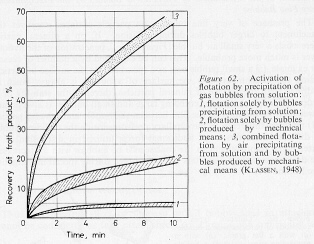
An Introduction to the Theory of Flotationpart of the Dissolved-Air Flotation bibliography of the Reef Aquarium Information Depot |
This book makes the following interesting claim (p. 113): "The presence of very fine bubbles on particle surfaces improves their attachment to larger bubbles during collision." To test this, the authors performed two experiments. Here's their description of the second one.
Experiment 2--In a laboratory pneumatic flotation machine, in the presence of oleic acid, fluorite was flotated under three different conditions of pulp aeration (fluorite size 0.147-0.074 mm). Air bubbles were obtained either by precipitation from solution or by passing air through a porous membrane, or by a combination of the two. These results showed that, in the third case, the flotation rate was much higher than in either of the other two (Figure 62).The larger class of bubbles in these experiments were larger than 500 microns. We're talking about mechanically-produced bubbles, rather than the larger bubbles (~50 microns) produced by precipitation and growth of air bubbles in water.

What I want to know is whether the position expressed above has withstood the test of time. Vrablik reported that free air on the high-pressure side of the pressure-relief nozzle must not be allowed to enter the flotation tank: "If the free air is not removed, flotator efficiency will be greatly impaired." [Vrablik59a]. Although the Klassen and Mokrousov book came out (in its English translation) a few years after the Vrablik paper, the claim in the Klassen and Mokrousov book is based on work published in 1948--eleven years before the Vrablik paper.
Leja's Surface Chemistry of Froth Flotation, p. 591, mention's Klassen's results, and reproduces the above figure, but does not add any commentary on whether the result is true. If the Klassen claim was considered valid as recently as 1982 (the date of Leja's book), then why am I not finding descriptions of DAF that involve the use of mechanically introduced bubbles alongside precipitated bubbles? Some papers mention that an excess of air hinders flotation. Is it just that enough air can be produced by precipitation alone? Even if more air is not desirable, doesn't Klassen's result indicate that flotation would work better if we replaced a portion of the precipitated air with larger bubbles?